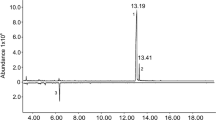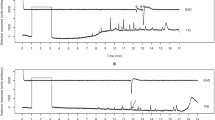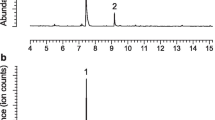Abstract
Female white pine cone beetles,Conophthorus coniperda, attacking second-year cones of eastern white pine,Pinus strobus L., produced a sex-specific pheromone that attracted conspecific males in laboratory bioassays and to field traps. Beetle response was enhanced by host monoterpenes. The female-produced compound was identified in volatiles collected on Porapak Q and in hindgut extracts as (+)-trans-pityol, (2R,5S)-(+)-2-(1-hydroxy-1-methylethyl)-5-methyltetrahydrofuran. Males and females produced and released the (E)-(-)-spiroacetal, (5S,7S)-(-)-7-methyl-1,6-dioxaspiro[4.5]decane, which was not an attractant for either sex, but acted as a repellent for males. Porapak Q-trapped volatiles from both sexes contained (+)-trans-pinocarveol and (-)-myrtenol. In addition, hindgut extracts of females containedtrans-verbenol, while males had pinocarvone and verbenone. Work in Georgia and Canada confirmed that the same isomers of pityol and spiroacetal are present in two distinct and widely separated populations ofC. coniperda.
Similar content being viewed by others
References
Bergstöm, G., Tengö, J., Reit W., andFrancke, W. 1982. Multicomponent mandibular gland secretion in three species ofAndrena bees (Hym.; Apoidae).Z. Naturforsch. 376:1124–1129.
Birgersson, G., andBergström, G. 1988. Volatiles released from individual spruce bark beetle entrance holes: quantitative variations during the first week of attack.J. Chem. Ecol. 15:2465–2483.
Birgersson, G., Schlyter, F., Löfqvist, J., andBergström, G. 1984. Quantitative variation of pheromone components in the spruce bark beetleIps typographus from different attack phases.J. Chem. Ecol. 10:1029–1055.
Birgersson, G. DeBarr, G.L., Dalusky, M.J., andBerisford, C.W. 1995. Pheromone production by the white pine beetle,Conophthorus coniperda (Schwarz) (Coleoptera: Scolytidae).Environ. Entomol. 24:In press.
Borden, J.H. 1985. Aggregation pheromones, pp. 275–285,in G.A. Kerkut and L.I. Gilbert (eds.). Behavior, Vol. 9, Comprehensive Insect Physiology, Biochemistry, and Pharmacology. Pergamon Press, Oxford.
Byers, J.A., Birgersson, G., Löfqvist, J., andBergström, G. 1988. Synergistic pheromones and monoterpenes enable aggregation and host recognition by a bark beetle.Naturwissenschaften 75:153–155.
Byers, J.A., Högberg, H.E., Unelius, R., Birgersson, G., andLöfqvist, J. 1989. Structure-activity studies on aggregation pheromone components ofPityogenes chalcographus (Coleoptera: Scolytidae): All stereoisomers of chalcogran and methyl 2,4-decadienoate.J. Chem. Ecol. 15:685–695.
DeBarr, G.L., Barber, L.R., andMaxwell, A.H. 1982. Use of carbofuran for control of eastern white pine cone and seed insects.For. Ecol. Manage. 4:1–8.
de Groot, P. 1992. Biosystematics ofConophthorus Hopkins (Coleoptera: Scolytidae) in eastern North America. PhD dissertation. Department of Biological Sciences, Simon Fraser University, Burnaby, British Columbia, Canada. 210 pp.
de Groot, P., DeBarr, G.L., Birgersson, G.O., Pierce, H.D., Borden, J.H., Berisford, Y.C., andBerisford, C.W. 1991. Evidence for a female-produced pheromone in the white pine cone beetle,Conophthorus coniperda (Schwarz), and in the red pine cone beetle,C. resinosae Hopkins (Coleoptera: Scolytidae).Can. Entomol. 123:1057–1064.
Delongchamps, P., Rowan, D.D., Pothier, N., Sauvé, T., andSaunders, J.K. 1981. 1,7-Dioxaspiro[5.5]undecanes. An excellent system for the study of stereoelectronic effects (anomeric- andexo-anomeric effects) in acetals.Can. J. Chem. 59:1105–1121.
Bobson, H.E.M. 1991. Analysis of flower and pollen volatiles, pp. 231–251,in H.F. Linskens and J.F. Jackson (eds.). Modern Methods of Plant Analysis, Essential Oils and Waxes, New Series, Vol. 12. Springer-Verlag, Berlin.
Francke, W., Heemann, V., Gerken, B., Renwick, J.A.A., andVité, J.P. 1977. 2-Ethyl-1,6-dioxaspiro[4.4]nonane, principal aggregation pheromone ofPityogenes chalcographus (L.).Naturwissenschaften 64:590–591.
Francke, W., Hindorf, G., andReith, W. 1979a. Alkyl-1,6-dioxaspiro[4.5]-decanes—a new class of pheromones.Naturwissenschaften 66:618–619.
Francke, W., Hindorf, G., andReith, W. 1979b. Mass-spectrometric fragmentation of alkyl-1,6-dioxaspiro[4.5]decanes.Naturwissenschaften 66:619–620.
Francke, W., Reith, R., andSinnwell, V. 1981. Bestimmung der relative Konfiguration bei Spiroacetalen durch1H-und13C-NMR Spektroskopie.Chem. Ber. 113:2686–2693.
Francke, W., Pan, M.-L., König, W.A., Mori, K., Puopoomchareon, P., Heuer, H., andVité, J.P. 1987. Identification of “Pityol” and “Grandisol” as pheromone components of the bark beetlePityophthorus pityographus.Naturwissenschaften 74:343–345.
Games, P.A., 1977. An improvedt table for simultaneous control ong contrasts.J. Am. Stat. Assoc. 72:531–534.
Garland, W.A., andPowell, M.L. 1981. Quantitative selected ion monitoring (QSIM) of drugs and/or metabolites in biological matrices.J. Chromatogr. Sci. 19:392–434.
Godwin, P.A., andOdell, T.M. 1965. The life history of the white pine cone beetle,Conophthorus coniperda.Ann. Entomol. Soc. Am. 58:213–219.
Grégoire, J.C., Coullien, D., Drumont, A., Meyer, H. andFrancke, W. 1992. Semiochemicals and the management ofRhizophagus grandis Gyll. (Col., Rhizophagidae) for the control ofDendroctonus micans Kug. (Col., Scolytidae).J. Appl. Entomol. 114:110–112.
Gries, G., Pierce, H.D., Jr., Lindgren, B.S., andBorden, J.H. 1988. New techniques for capturing and analyzing semiochemicals for scolytid beetles (Coleoptera: Scolytidae).J. Econ. Entomol. 81:1715–1720.
Hedlin, A.F., Yates, H.O., III, Tovar, D.C., Ebel, B.H., Koerber, T.W., andMerkel, E.P. 1980. Cone and seed insects on North American conifers. Canadian Forestry Service, United States Forest Service, Secretaría de Agricultura y Recursos Hidráulicos, México. 122 pp.
Herdy, H. 1959. A method of determining the sex of adult bark beetles of the genusConophthorus.Can. Dep. Agric., For. Biol. Div., Bi-Mon. Prog. Rep. 15:1–2.
Jacobson, R., Taylor, R.J., Williams, H.J., andSmith, L.R. 1982. Naturally occurring spirocyclic ketals from lactones.J. Org. Chem. 47:3140–3142.
Jones, D. 1984. Use, misuse, and role of multiple-comparison procedures in ecological and agricultural entomology.Environ. Entomol. 13:635–649.
Joshi, V.S., Damodaran, N.P., andDev, S. 1968. Organic reactions in a solid matrix—aluminia induced oxiranes rearrangements.Tetrahedron 24:5817–5830.
Kinzer, H.G., andReeves, J.M. 1976. Biology and behavior of cone beetles of ponderosa pine and southwestern white pine in New Mexico. New Mexico State University, Agriculture Experiment Station Bulletin 641. 28 pp.
Kinzer, H.G., Ridgill, B.J., andReeves, J.M. 1972. Response of walkingConophthorus coniperda to volatile attractions.J. Econ. Entomol. 65:726–729.
Klimetzek, D., Bartels, J., andFrancke W. 1989. Das Pheromon-System des Bunten UlmenbastkäfersPteleobius vittatus (F.) (Col., Scolytidae).J. Appl. Entomol. 107:518–523.
Kohnle, U., Densborn, S., Kölsch, P., Meyer, H., andFrancke W. 1992. (E)-7-methyl-1,6-dioxaspiro[4.5]decane in the chemical communication of European Scolytidae and Nitidulidae (Coleoptera).J. Appl. Entomol. 114:187–192.
König, W.A., Krebber, R., andWenz, G. 1989. Enantioselective capillary gas chromatography on the basis of host-guest interactions with modified cyclodextrins.J. High Resolut. Chromatogr. 12:641–644.
Lindgren, B.S. 1983. A multiple funnel trap for scolytid beetles (Coleoptera).Can. Entomol. 115:229–302.
Mattson, W.J., Tabashnik, B.E., andMiller, J.R. 1984. Developing a conceptual model of cone-finding behavior by the red pine cone beetle,Conophthorus resinosae Hopkins (Coleoptera: Scolytidae), pp. 65–76,in H.O. Yates, III (ed.). Proceedings Cone and Seed Insects Conference. IUFRO Working Party S2.07-1. USDA, Southeastern Forest Experiment Station, Asheville, North Carolina.
Mattson, W.J., andStrauss, S.H. 1986. Are cone volatiles involved in cone finding by the red pine cone beetle,Conophthorus resinosae (Coleoptera: Scolytidae), pp. 185–204,in A. Roques, (ed.). Proceedings, 2nd Cone and Seed Insects Conference. IUFRO Working Party S2.07-01. INRA Ardon, France.
Mirov, N.T. 1961. Composition of gum terpentines of pines. USDA Forest Service, P.S.W. Forest and Range Experiment Station Technical Bulletin, 1239. 158 pp.
Mori, K., andPuapoomchareon, P. 1987. Pheromone synthesis, part 98. Conversion of the enantiomers of sulcatol (6-methyl-5-hepten-2-ol) to the enantiomers of pityol [trans-2-(1-hydroxy-1-methylethyl)-5-methyltetrahydrofuran], a male specific attractant of the bark beetlePityophthorus pityographus.Liebig's Ann. Chem. 1987:271–272.
Payne, T.L., Hart, E.R., Edson, L.J., McCarty, F.A., Billings, R.F., andCoster, J.E. 1976. Olfactometer for assay of behavioral chemicals for the southern pine beetle,Dendroctonus frontalis (Coleoptera: Scolytidae).J. Chem. Ecol. 2:411–419.
Pierce, H.D., Jr., de Groot, P., Borden, J.H., Ramaswamy, S., andOehlschlager, A.C. 1995. Pheromones in the red pine cone beetle,Conophthorus resinosae Hopkins, and its synonym,C. banksianae McPherson (Coleoptera: Scolytidae).J. Chem. Ecol. 21:169–185.
SAS Institute. 1987. SAS/SAT Guide for personal computers, Version 6 ed. SAS Institute Inc., Cary, North Carolina. 1028 pp.
Schurig, V., andWeber, R. 1984. Use of glass and fused silica open tubular columns for the separation of structural, configurational and optical isomers by selective complexation gas chromatrography.J. Chromatogr. 289:321–332.
Šidák, Z. 1967. Rectangular confidence regions for the means of multivariate normal distributions.J. Am. Stat. Assoc. 62:626–633.
Tengö, J., Ågren, L., Baur, B., Isaksson, R., Liljefors, T., Mori, K., König, W., andFrancke, W. 1990.Andrena wilkella male bees discriminate between enantiomers of cephalic secretion components.J. Chem. Ecol. 16:429–441.
Wood, S.L. 1982. The bark and ambrosia beetles in North and Central America (Coleoptera: Scolytidae). A taxonomic monograph.Great Basin Nat. Mem. 6:1359 pp.
Author information
Authors and Affiliations
Rights and permissions
About this article
Cite this article
Birgersson, G., Debarr, G.L., de Groot, P. et al. Pheromones in white pine cone beetle,Conophthorus coniperda (schwarz) (Coleoptera: Scolytidae). J Chem Ecol 21, 143–167 (1995). https://doi.org/10.1007/BF02036648
Received:
Accepted:
Issue Date:
DOI: https://doi.org/10.1007/BF02036648




